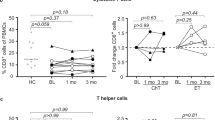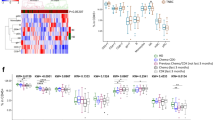Abstract
Abnormal accumulation of myeloid-derived suppressor cells (MDSC) is an important mechanism of tumor immune evasion. Cyclophosphamide (CTX) has also been shown in non-tumor bearing animals to cause transient surges in MDSC. Knowledge of MDSC is primarily based on preclinical work, and to date only few published studies have involved cancer patients. The goal of this study was to test the hypothesis that circulating MDSC levels correlate with clinical cancer stage, CTX-based chemotherapy, and metastatic tumor burden. Whole blood was collected from 106 newly diagnosed solid tumor patients (stages I–IV). Percentages of circulating MDSC (Lin−/Lo, HLA DR−, CD33+CD11b+) were determined prior to initiation of systemic therapy. In 17 early stage breast cancer patients receiving doxorubicin–cyclophosphamide chemotherapy every 14 days (ddAC) blood was collected on day 1 of each cycle. Circulating MDSC were significantly increased in cancer patients of all stages relative to healthy volunteers. A significant correlation between circulating MDSC and clinical cancer stage was also observed. Moreover, among stage IV patients, those with extensive metastatic tumor burden had the highest percent and absolute number of MDSC. Significant increases in circulating MDSC were observed with ddAC when compared with pretreatment levels. Circulating MDSC levels correlate with clinical cancer stage, ddAC, and metastatic tumor burden. This information must be incorporated into the design of future trials exploring immune-based therapeutic strategies. Pharmacologic modulation of MDSC should also be tested in future clinical trials.







Similar content being viewed by others
References
Almand B, Clark JI, Nikitina E, van Beynen J, English NR, Knight SC, Carbone DP, Gabrilovich DI (2001) Increased production of immature myeloid cells in cancer patients: a mechanism of immunosuppression in cancer. J Immunol 166:678
Almand B, Resser JR, Lindman B, Nadaf S, Clark JI, Kwon ED, Carbone DP, Gabrilovich DI (2000) Clinical significance of defective dendritic cell differentiation in cancer. Clin Cancer Res 6:1755
Angulo I, de las Heras FG, Garcia-Bustos JF, Gargallo D, Munoz-Fernandez MA, Fresno M (2000) Nitric oxide-producing CD11b(+) Ly-6G(Gr-1)(+) CD31(ER-MP12)(+) cells in the spleen of cyclophosphamide-treated mice: implications for T cell responses in immunosuppressed mice. Blood 95:212
Appay V, Reynard S, Voelter V, Romero P, Speiser DE, Leyvraz S (2006) Immuno-monitoring of CD8+ T cells in whole blood versus PBMC samples. J Immunol Methods 309:192
Brito C, Naviliat M, Tiscornia AC, Vuillier F, Gualco G, Dighiero G, Radi R, Cayota AM (1999) Peroxynitrite inhibits T lymphocyte activation and proliferation by promoting impairment of tyrosine phosphorylation and peroxynitrite-driven apoptotic death. J Immunol 162:3356
Bronte V, Apolloni E, Cabrelle A, Ronca R, Serafini P, Zamboni P, Restifo NP, Zanovello P (2000) Identification of a CD11b(+)/Gr-1(+)/CD31(+) myeloid progenitor capable of activating or suppressing CD8(+) T cells. Blood 96:3838
Bronte V, Serafini P, De Santo C, Marigo I, Tosello V, Mazzoni A, Segal DM, Staib C, Lowel M, Sutter G et al (2003) IL-4-induced arginase 1 suppresses alloreactive T cells in tumor-bearing mice. J Immunol 170:270
Bronte V, Wang M, Overwijk WW, Surman DR, Pericle F, Rosenberg SA, Restifo NP (1998) Apoptotic death of CD8+ T lymphocytes after immunization: induction of a suppressive population of Mac-1+/Gr-1+ cells. J Immunol 161:5313
Citron ML, Berry DA, Cirrincione C, Hudis C, Winer EP, Gradishar WJ, Davidson NE, Martino S, Livingston R, Ingle JN et al (2003) Randomized trial of dose-dense versus conventionally scheduled, sequential versus concurrent combination chemotherapy as postoperative adjuvant treatment of node-positive primary breast cancer: first report of intergroup trial C9741/cancer, leukemia group B trial 9741. J Clin Oncol 21:1431
Curiel TJ (2007) Tregs and rethinking cancer immunotherapy. J Clin Invest 117:1167
Filipazzi P, Valenti R, Huber V, Pilla L, Canese P, Iero M, Castelli C, Mariani L, Parmiani G, Rivoltini L (2007) Identification of a new subset of myeloid suppressor cells in peripheral blood of melanoma patients with modulation by a granulocyte–macrophage colony-stimulation factor-based antitumor vaccine. J Clin Oncol 25:2546
Fricke I, Mirza N, Dupont J, Lockhart C, Jackson A, Lee JH, Sosman JA, Gabrilovich DI (2007) Vascular endothelial growth factor-trap overcomes defects in dendritic cell differentiation but does not improve antigen-specific immune responses. Clin Cancer Res 13:4840
Gallina G, Dolcetti L, Serafini P, De Santo C, Marigo I, Colombo MP, Basso G, Brombacher F, Borrello I, Zanovello P et al (2006) Tumors induce a subset of inflammatory monocytes with immunosuppressive activity on CD8+ T cells. J Clin Invest 116:2777
Horstmann E, McCabe, Grochow L, Yamamoto S, Rubinstein L, Budd T, Shoemaker D, Emanuel EJ, Grady C (2005) Risks and benefits of phase 1 oncology trials, 1991 through 2002. N Engl J Med 352:895–904
Kusmartsev S, Gabrilovich DI (2002) Immature myeloid cells and cancer-associated immune suppression. Cancer Immunol Immunother 51:293
Kusmartsev S, Gabrilovich DI (2003) Inhibition of myeloid cell differentiation in cancer: the role of reactive oxygen species. J Leukoc Biol 74:186
Kusmartsev S, Nefedova Y, Yoder D, Gabrilovich DI (2004) Antigen-specific inhibition of CD8+ T cell response by immature myeloid cells in cancer is mediated by reactive oxygen species. J Immunol 172:989
Kusmartsev SA, Li Y, Chen SH (2000) Gr-1+ myeloid cells derived from tumor-bearing mice inhibit primary T cell activation induced through CD3/CD28 costimulation. J Immunol 165:779
Lathers DM, Achille N, Kolesiak K, Hulett K, Sparano A, Petruzzelli GJ, Young MR (2001) Increased levels of immune inhibitory CD34+ progenitor cells in the peripheral blood of patients with node positive head and neck squamous cell carcinomas and the ability of these CD34+ cells to differentiate into immune stimulatory dendritic cells. Otolaryngol Head Neck Surg 125:205
Lutsiak ME, Semnani RT, De Pascalis R, Kashmiri SV, Schlom J, Sabzevari H (2005) Inhibition of CD4(+) 25+ T regulatory cell function implicated in enhanced immune response by low-dose cyclophosphamide. Blood 105:2862
Machiels JP, Reilly RT, Emens LA, Ercolini AM, Lei RY, Weintraub D, Okoye FI, Jaffee EM (2001) Cyclophosphamide, doxorubicin, and paclitaxel enhance the antitumor immune response of granulocyte/macrophage-colony stimulating factor-secreting whole-cell vaccines in HER-2/neu tolerized mice. Cancer Res 61:3689
Melani C, Chiodoni C, Forni G, Colombo MP (2003) Myeloid cell expansion elicited by the progression of spontaneous mammary carcinomas in c-erbB-2 transgenic BALB/c mice suppresses immune reactivity. Blood 102:2138
Pandit R, Lathers DM, Beal NM, Garrity T, Young MR (2000) CD34+ immune suppressive cells in the peripheral blood of patients with head and neck cancer. Ann Otol Rhinol Laryngol 109:749
Romeu MA, Mestre M, Gonzalez L, Valls A, Verdaguer J, Corominas M, Bas J, Massip E, Buendia E (1992) Lymphocyte immunophenotyping by flow cytometry in normal adults: comparison of fresh whole blood lysis technique, Ficoll–Paque separation and cryopreservation. J Immunol Methods 154:7
Salem ML, Kadima AN, El-Naggar SA, Rubinstein MP, Chen Y, Gillanders WE, Cole DJ (2007) Defining the ability of cyclophosphamide preconditioning to enhance the antigen-specific CD8+ T cell response to peptide vaccination: creation of a beneficial host microenvironment involving type I IFNs and myeloid cells. J Immunother 30:40
Schlom J, Arlen PM, Gulley JL (2007) Cancer vaccines: moving beyond current paradigms. Clin Cancer Res 13:3776
Serafini P, Meckel K, Kelso M, Noonan K, Califano J, Koch W, Dolcetti L, Bronte V, Borrello I (2006) Phosphodiesterase-5 inhibition augments endogenous antitumor immunity by reducing myeloid-derived suppressor cell function. J Exp Med 203:2691–2702
Suzuki E, Kapoor V, Jassar AS, Kaiser LR, Albelda SM (2005) Gemcitabine selectively eliminates splenic Gr-1+/CD11b+ myeloid suppressor cells in tumor-bearing animals and enhances antitumor immune activity. Clin Cancer Res 11:6713
Talmadge JE, Hood KC, Zobel LC, Shafer LR, Coles M, Toth B (2007) Chemoprevention by cyclooxygenase-2 inhibition reduces immature myeloid suppressor cell expansion. Int Immunopharmacol 7:140
Zea AH, Rodriguez PC, Atkins MB, Hernandez C, Signoretti S, Zabaleta J, McDermott D, Quiceno D, Youmans A, O’Neill A et al (2005) Arginase-producing myeloid suppressor cells in renal cell carcinoma patients: a mechanism of tumor evasion. Cancer Res 65:3044
Acknowledgments
The authors would like to thank Amir Al Khami, Tracy Vandenberg, and Steven Hutchens for technical support, and Kristi Vissage for data analysis. Special thanks to Paolo Serafini for critical review of the manuscript. This work was supported in part by a Chain Reaction for the Cure Grant http://www.chainreactionforacure.org/, a seed grant from Hollings Cancer Center and R01CA83672. Funding sources has no involvement in any aspect of conducting this research, data analysis, or manuscript preparation for publication.
Conflict of interest statement
Authors declare no conflicts of interest.
Author information
Authors and Affiliations
Corresponding author
Rights and permissions
About this article
Cite this article
Diaz-Montero, C.M., Salem, M.L., Nishimura, M.I. et al. Increased circulating myeloid-derived suppressor cells correlate with clinical cancer stage, metastatic tumor burden, and doxorubicin–cyclophosphamide chemotherapy. Cancer Immunol Immunother 58, 49–59 (2009). https://doi.org/10.1007/s00262-008-0523-4
Received:
Accepted:
Published:
Issue Date:
DOI: https://doi.org/10.1007/s00262-008-0523-4




